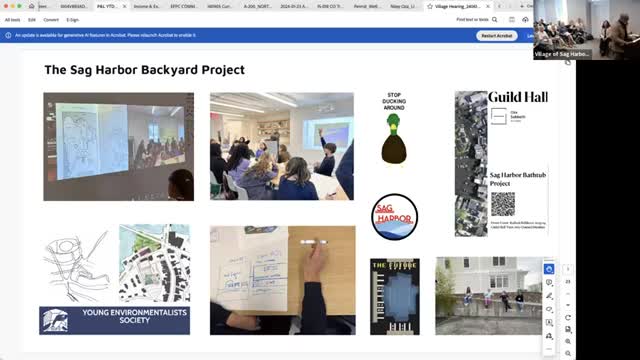Sag Harbor faces chronic flooding crisis demands urgent action
June 14, 2024 | Sag Harbor, Suffolk County, New York

This article was created by AI summarizing key points discussed. AI makes mistakes, so for full details and context, please refer to the video of the full meeting. Please report any errors so we can fix them. Report an error »

Residents of Sag Harbor are increasingly concerned about chronic flooding in the area, particularly in the backyard parking lot that has been a persistent issue for decades. During a recent government meeting, a local practitioner shared insights from a year-long project involving young people from the Young Environment Society and the teen arts council at Guildhall. Their work culminated in a presentation at the Long Island Sound Research Conference, focusing on the phenomenon of compound flooding—a convergence of heavy rainfall, storm surge, and high groundwater levels.
The project highlighted that the area from Long Island Avenue to Spring Street is particularly vulnerable due to its geographical and historical context. The speaker noted that this region has experienced flooding for centuries, a factor that influenced the settlement patterns of Sag Harbor in the late 1600s. Historical records indicate that the landscape, originally a series of hills and bluffs within marshland, has been significantly altered over time, yet the topography continues to affect local flooding dynamics.
The speaker emphasized the need for corrective measures to address the ongoing flooding issues, which they argue are part of Sag Harbor's \"urban DNA.\" The presentation included findings from a 2016 water quality management study commissioned by the village's harbor committee, which mapped the various watersheds in Sag Harbor, further underscoring the area's susceptibility to flooding.
As discussions continue, the community is urged to consider both historical context and modern environmental challenges in developing effective strategies to mitigate flooding risks in Sag Harbor.
The project highlighted that the area from Long Island Avenue to Spring Street is particularly vulnerable due to its geographical and historical context. The speaker noted that this region has experienced flooding for centuries, a factor that influenced the settlement patterns of Sag Harbor in the late 1600s. Historical records indicate that the landscape, originally a series of hills and bluffs within marshland, has been significantly altered over time, yet the topography continues to affect local flooding dynamics.
The speaker emphasized the need for corrective measures to address the ongoing flooding issues, which they argue are part of Sag Harbor's \"urban DNA.\" The presentation included findings from a 2016 water quality management study commissioned by the village's harbor committee, which mapped the various watersheds in Sag Harbor, further underscoring the area's susceptibility to flooding.
As discussions continue, the community is urged to consider both historical context and modern environmental challenges in developing effective strategies to mitigate flooding risks in Sag Harbor.
View full meeting
This article is based on a recent meeting—watch the full video and explore the complete transcript for deeper insights into the discussion.
View full meeting
